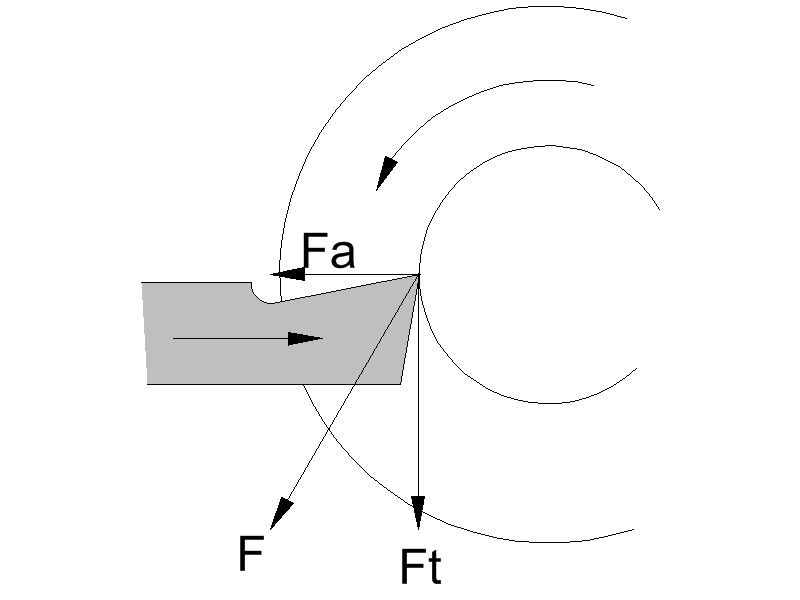How do I get past this mental block about the direction of forces on the tool tip? OK, let’s see if this works: this link will take you to Sandvik’s home page.
**LINK**
Click on the ‘Knowledge’ tab, at the bottom of the next screen you’ll see a globe, scroll down to ‘register for our free e-learning…’ and click on that – you won’t need to register. Next page click ‘Introduction’ in the left panel, click the yellow ‘Training Manual’ panel to down load the manual.
When you go into the downloaded zip file, open MCT.pdf and scroll through to page A57, where you will find a diagram of forces acting on the tip of a boring tool (for some reason they don’t show the forces on an external tool anywhere that I can find, so you’ll have to imagine what it would be like). Note how the forces are directed – tangential force Ft perpendicularly down, feed force Fa, opposite way to the feed direction, and radial force Fr, AWAY from the work surface, it is not directed into the work surface.
Now think parting tool on the outside – the forces will be directed in the same directions relative to the tip of the tool, so we end up with:

Fr isn’t present now, it’s effectively part of Fa. F is the resultant force on the tool tip, down and out, exactly as I showed it.
The hardness of the material, in conjunction with the feed rate and depth of cut, determine the relative magnitudes of Fa and Ft, and therefore the magnitude and direction of F…oh look, another sketch…
HEALTH WARNING: much simplified re the forces at the tool tip, intended only to be illustrative, and to get your thinking into a different mode!

Sketches show a single tooth hacksaw blade sitting on a piece of mild steel, A. At B, you push the blade forward only, it does not cut. Similarly at C, you push downwards only – again, it does not cut.
Since you’re pushing, you’re exerting a force, so the arrows also show the direction of the force, with the length of the arrows representing the magnitude of the force that your applying. More force, longer arrow.
At D you’re pushing along and in, it cuts. The resultant of the along and down forces is the angled arrow pointing down and to the right. At E, the forces are moved to the cutting edge, as that’s where they are being applied.
As my good friend Isaac pointed out in 1687, every action has an equal and opposite reaction, so as the tip pushes down on the steel, the steel pushes back on the tip with the same magnitude and direction, F.
G – I is a softer material (e.g. aluminium), less down force needed, so the down arrow is shorter, the resultant is shorter and at a reduced angle, as is the reaction force on the tip.
J – L are for a harder material (stainless steel?), more down force needed to push the blade into the cut, reaction force on the tip is larger, but this time at an increased angle to the surface being cut.
G – I could also represent steel with a shallower depth of cut, J – L steel with an increased depth of cut.
Note that Sandvik make no comment with regard to any possibility of arriving at a force that would drag the tool into the work, surely they would have done so had it had the potential to cause disaster? The Training Manual mentions with all sorts of machining problems, so why ignore that one, if it exists? Or perhaps it’s because they never, in their wildest dreams, thought anyone would try to cut brass with a tip designed for aluminium, as Chris did? (Sorry Chris, I couldn’t resist that one!)
Back to the boring tool – can you think of anything that would better demonstrate that there isn’t any force trying to pull the tool in to the work? If there were such a force, wouldn’t the boring bar (probably the most flexible tool in our armoury) get pulled in? It would indeed get pulled in, and viciously. And if somehow it were to be pulled in in a ‘non-vicious’ manner, it would bore oversize. But that doesn’t happen, if anything, it bores undersize – it gets pushed OUT, so that we have to ‘work the spring out of the tool’ to get the bore to size. So the boring tool also demonstrates that the force is ‘out’ and not ‘in’.
Oh yes, another point about the boring tool system – the downward force Ft tends to INCREASE the depth of cut as it pushes the tool down, which would be a perfect situation for dig in to occur, if the tool were not being pushed out of the work. And not only is it pushed out, but as you can see from the diagrams above, the deeper cut results in more force pushing the tool out. Hence, no dig in.
How does that float yer boat?
Mark C.






